Using Optical Tracking System Data to Measure Team Synergic Behavior: Synchronization of Player-Ball-Goal Angles in a Football Match
Abstract
1. Introduction
1.1. Tracking Data in Football
1.2. Synergies in Sports
1.3. The Properties of Team Synergies in Sports
1.4. Cluster Phase Analysis
2. Methodology
2.1. Kinematic Spatiotemporal Data
2.2. Cluster Phase Analysis and Player-Ball-Goal Angles
3. Results
3.1. Dimensional Compression
3.2. Reciprocal Compensation
3.3. Interpersonal Linkages
3.4. Degeneracy
4. Discussion
5. Conclusions
Author Contributions
Funding
Acknowledgments
Conflicts of Interest
References
- Linke, D.; Link, D.; Lames, M. Football-specific validity of TRACAB’s optical video tracking systems. PLoS ONE 2020, 15, e0230179. [Google Scholar] [CrossRef] [PubMed]
- Rodrigues, A.C.N.; Pereira, A.S.; Mendes, R.M.S.; Araújo, A.G.; Couceiro, M.S.; Figueiredo, A.J. Using Artificial Intelligence for Pattern Recognition in a Sports Context. Sensors 2020, 20, 3040. [Google Scholar] [CrossRef]
- Hodder, R.W.; Ball, K.A.; Serpiello, F.R. Criterion Validity of Catapult ClearSky T6 Local Positioning System for Measuring Inter-Unit Distance. Sensors 2020, 20, 3693. [Google Scholar] [CrossRef] [PubMed]
- Rein, R.; Memmert, D. Big data and tactical analysis in elite soccer: Future challenges and opportunities for sports science. SpringerPlus 2016, 5, 1410. [Google Scholar] [CrossRef] [PubMed]
- Araújo, D.; Davids, K. Team Synergies in Sport: Theory and Measures. Front. Psychol. 2016, 7, 1449. [Google Scholar] [CrossRef]
- Silva, P.; Garganta, J.; Araújo, D.; Davids, K.; Aguiar, P. Shared Knowledge or Shared Affordances? Insights from an Ecological Dynamics Approach to Team Coordination in Sports. Sports Med. 2013, 43, 765–772. [Google Scholar] [CrossRef]
- Woods, C.T.; McKeown, I.; Rothwell, M.; Araújo, D.; Robertson, S.; Davids, K. Sport practitioners as sport ecology designers: How ecological dynamics has progressively changed perceptions of skill “acquisition” in the sporting habitat. Front. Psychol. 2020, 11, 654. [Google Scholar] [CrossRef]
- Button, C.; Wheat, J.; Lamb, P. Why coordination dynamics is relevant for studying sport performance. In Complex Systems in Sport, 1st ed.; Davids, K., Hristovski, R., Araújo, D., Balagué, N., Button, C., Passos, P., Eds.; Routledge: London, UK, 2015; pp. 44–61. [Google Scholar]
- Hristovski, R.; Balagué, N.; Schöllhorn, W.I. Basic notions in the science of complex systems and nonlinear dynamics. In Complex Systems in Sport, 1st ed.; Davids, K., Hristovski, R., Araújo, D., Balagué, N., Button, C., Passos, P., Eds.; Routledge: London, UK, 2015; pp. 3–17. [Google Scholar]
- Silva, P.; Vilar, L.; Davids, K.; Araújo, D.; Garganta, J. Sports teams as complex adaptive systems: Manipulating player numbers shapes behaviours during football small-sided games. SpringerPlus 2016, 5, 191. [Google Scholar] [CrossRef]
- Diniz, A.; Passos, P. Modelling Interpersonal Coordination. In Interpersonal Coordination and Performance in Social Systems, 1st ed.; Passos, P., Davids, K., Chow, J.Y., Eds.; Routledge: London, UK, 2017; pp. 294–304. [Google Scholar]
- Riley, M.A.; Richardson, M.J.; Shockley, K.; Ramenzoni, V.C. Interpersonal Synergies. Front. Psychol. 2011, 2. [Google Scholar] [CrossRef]
- Bernstein, N.A. The Co-Ordination and Regulation of Movements, 1st English ed.; Pergamon Press: New York, NY, USA, 1967. [Google Scholar]
- Bruton, M.; O’Dwyer, N. Synergies in coordination: A comprehensive overview of neural, computational, and behavioral approaches. J. Neurophysiol. 2018, 120, 2761–2774. [Google Scholar] [CrossRef]
- Turvey, M.T. Action and perception at the level of synergies. Hum. Mov. Sci. 2007, 26, 657–697. [Google Scholar] [CrossRef] [PubMed]
- Profeta, V.L.S.; Turvey, M.T. Bernstein’s levels of movement construction: A contemporary perspective. Hum. Mov. Sci. 2018, 57, 111–133. [Google Scholar] [CrossRef] [PubMed]
- Frencken, W.; Lemmink, K.; Delleman, N.; Visscher, C. Oscillations of centroid position and surface area of soccer teams in small-sided games. Eur. J. Sport Sci. 2011, 11, 215–223. [Google Scholar] [CrossRef]
- Duarte, R.; Araújo, D.; Correia, V.; Davids, K.; Marques, P.; Richardson, M.J. Competing together: Assessing the dynamics of team–team and player–team synchrony in professional association football. Hum. Mov. Sci. 2013, 32, 555–566. [Google Scholar] [CrossRef] [PubMed]
- Folgado, H.; Lemmink, K.A.P.M.; Frencken, W.; Sampaio, J. Length, width and centroid distance as measures of teams tactical performance in youth football. Eur. J. Sport Sci. 2014, 14, S487–S492. [Google Scholar] [CrossRef]
- Fonseca, S.; Milho, J.; Travassos, B.; Araújo, D. Spatial dynamics of team sports exposed by Voronoi diagrams. Hum. Mov. Sci. 2012, 31, 1652–1659. [Google Scholar] [CrossRef]
- Rein, R.; Raabe, D.; Perl, J.; Memmert, D. Evaluation of changes in space control due to passing behavior in elite soccer using Voronoi-cells. In Advances in Intelligent Systems and Computing, Proceedings of the 10th International Symposium on Computer Science in Sports (ISCSS), Loughborough, UK, 9–11 September 2015; Chung, P., Soltoggio, A., Dawson, C.W., Meng, Q., Pain, M., Eds.; Springer: Cham, Switzerland, 2016. [Google Scholar]
- López-Felip, M.A.; Davis, T.J.; Frank, T.D.; Dixon, J.A. A cluster phase analysis for collective behavior in team sports. Hum. Mov. Sci. 2018, 59, 96–111. [Google Scholar] [CrossRef]
- Clemente, F.M.; Castillo, D.; Los Arcos, A. Tactical analysis according to age-level groups during a 4 vs. 4 plus goalkeepers small-sided game. Int. J. Environ. Res. Public Health 2020, 17, 1667. [Google Scholar] [CrossRef]
- Silva, P.; Chung, D.; Carvalho, T.; Cardoso, T.; Davids, K.; Araújo, D.; Garganta, J. Practice effects on intra-team synergies in football teams. Hum. Mov. Sci. 2016, 46, 39–51. [Google Scholar] [CrossRef]
- Duarte, R.; Araújo, D.; Correia, V.; Davids, K. Sports teams as superorganisms: Implications of sociobiological models of behaviour for research and practice in team sports performance analysis. Sports Med. 2012, 42, 633–642. [Google Scholar] [CrossRef]
- Sumpter, D.J.T.; Mann, R.P.; Perna, A. The modelling cycle for collective animal behaviour. Interface Focus 2012, 2, 764–773. [Google Scholar] [CrossRef] [PubMed]
- Couzin, I.D. Collective cognition in animal groups. Trends Cogn. Sci. 2009, 13, 36–43. [Google Scholar] [CrossRef] [PubMed]
- Cervone, D.; Bornn, L.; Goldsberry, K. NBA Court Realty. In Proceedings of the MIT Sloan Sports Analytics Conference, Boston, MA, USA, 11–12 March 2016. [Google Scholar]
- Spearman, W.; Basye, A.; Dick, G.; Hotovy, R.; Pop, P. Physics-Based Modeling of Pass Probabilities in Soccer. In Proceedings of the MIT Sloan Sports Analytics Conference, Boston, MA, USA, 3–4 March 2017. [Google Scholar]
- Spearman, W. Beyond Expected Goals. In Proceedings of the MIT Sloan Sports Analytics Conference, Boston, MA, USA, 23–24 February 2018. [Google Scholar]
- Fernández, J.; Bornn, L.; Cervone, D. Decomposing the Immeasurable Sport: A deep learning expected possession value framework for soccer. In Proceedings of the MIT Sloan Sports Analytics Conference, Boston, MA, USA, 1–2 March 2019. [Google Scholar]
- Fernández, J.; Bornn, L. Wide Open Spaces: A statistical technique for measuring space creation in professional soccer. In Proceedings of the MIT Sloan Sports Analytics Conference, Boston, MA, USA, 1–2 March 2019. [Google Scholar]
- Passos, P.; Davids, K.; Araújo, D.; Paz, N.; Minguéns, J.; Mendes, J. Networks as a novel tool for studying team ball sports as complex social systems. J. Sci. Med. Sport 2011, 14, 170–176. [Google Scholar] [CrossRef] [PubMed]
- Ramos, J.; Lopes, R.J.; Marques, P.; Araújo, D. Hypernetworks Reveal Compound Variables That Capture Cooperative and Competitive Interactions in a Soccer Match. Front. Psychol. 2017, 8, 1379. [Google Scholar] [CrossRef]
- Ribeiro, J.; Davids, K.; Araújo, D.; Silva, P.; Ramos, J.; Lopes, R.; Garganta, J. The Role of Hypernetworks as a Multilevel Methodology for Modelling and Understanding Dynamics of Team Sports Performance. Sports Med. 2019, 49, 1337–1344. [Google Scholar] [CrossRef]
- Shaw, L.; Glickman, M. Dynamic analysis of team strategy in professional football. In Proceedings of the Barça Sports Analytics Summit, Barcelona, Spain, 13 November 2019. [Google Scholar]
- Travassos, B.; Araújo, D.; Duarte, R.; McGarry, T. Spatiotemporal coordination behaviors in futsal (indoor football) are guided by informational game constraints. Hum. Mov. Sci. 2012, 31, 932–945. [Google Scholar] [CrossRef]
- Frank, T.D.; Richardson, M.J. On a test statistic for the Kuramoto order parameter of synchronization: An illustration for group synchronization during rocking chairs. Phys. Nonlinear Phenom. 2010, 239, 2084–2092. [Google Scholar] [CrossRef]
- Acebrón, J.A.; Bonilla, L.L.; Vicente, C.J.P.; Ritort, F.; Spigler, R. The Kuramoto model: A simple paradigm for synchronization phenomena. Rev. Mod. Phys. 2005, 77, 137–185. [Google Scholar] [CrossRef]
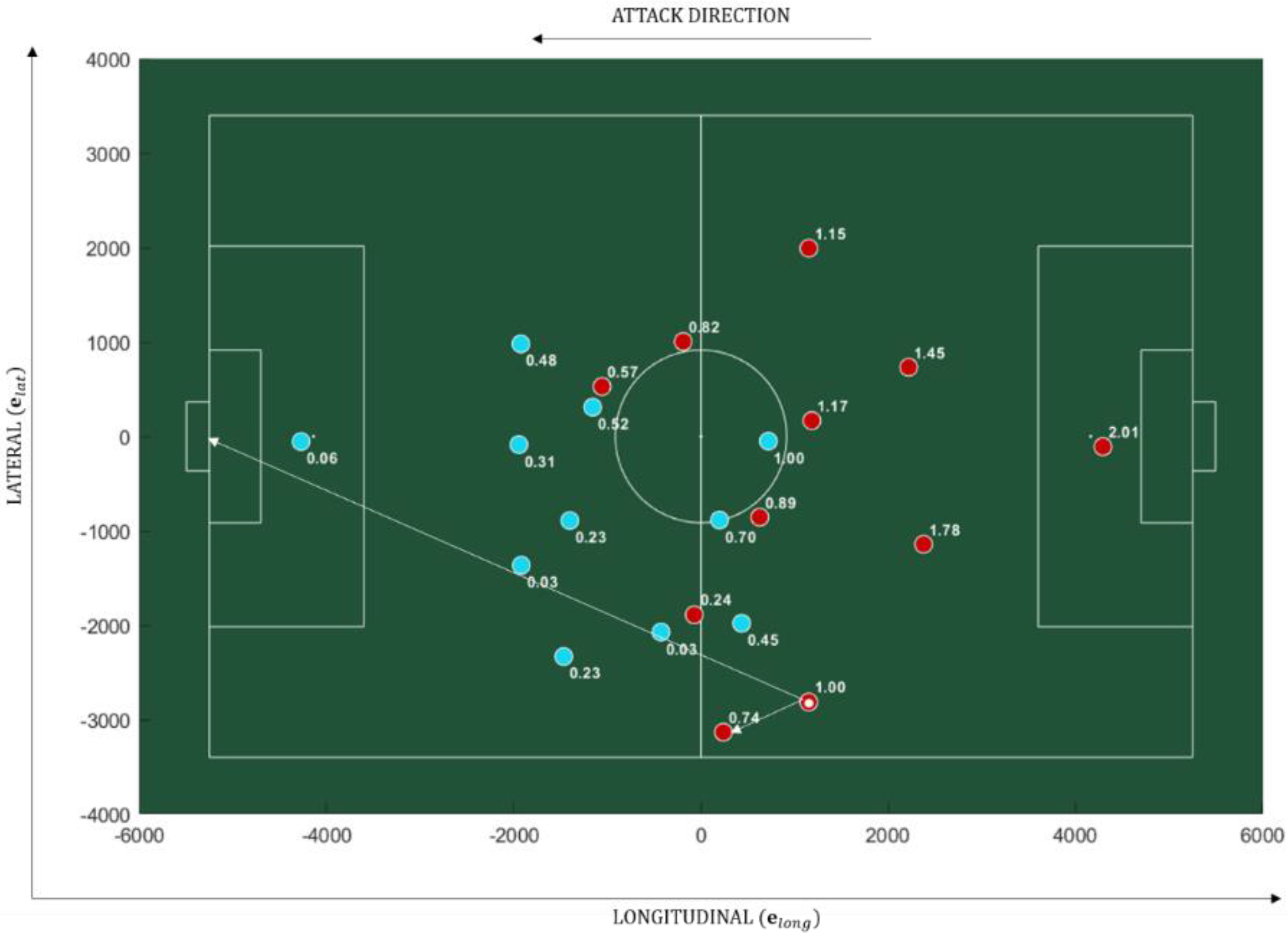
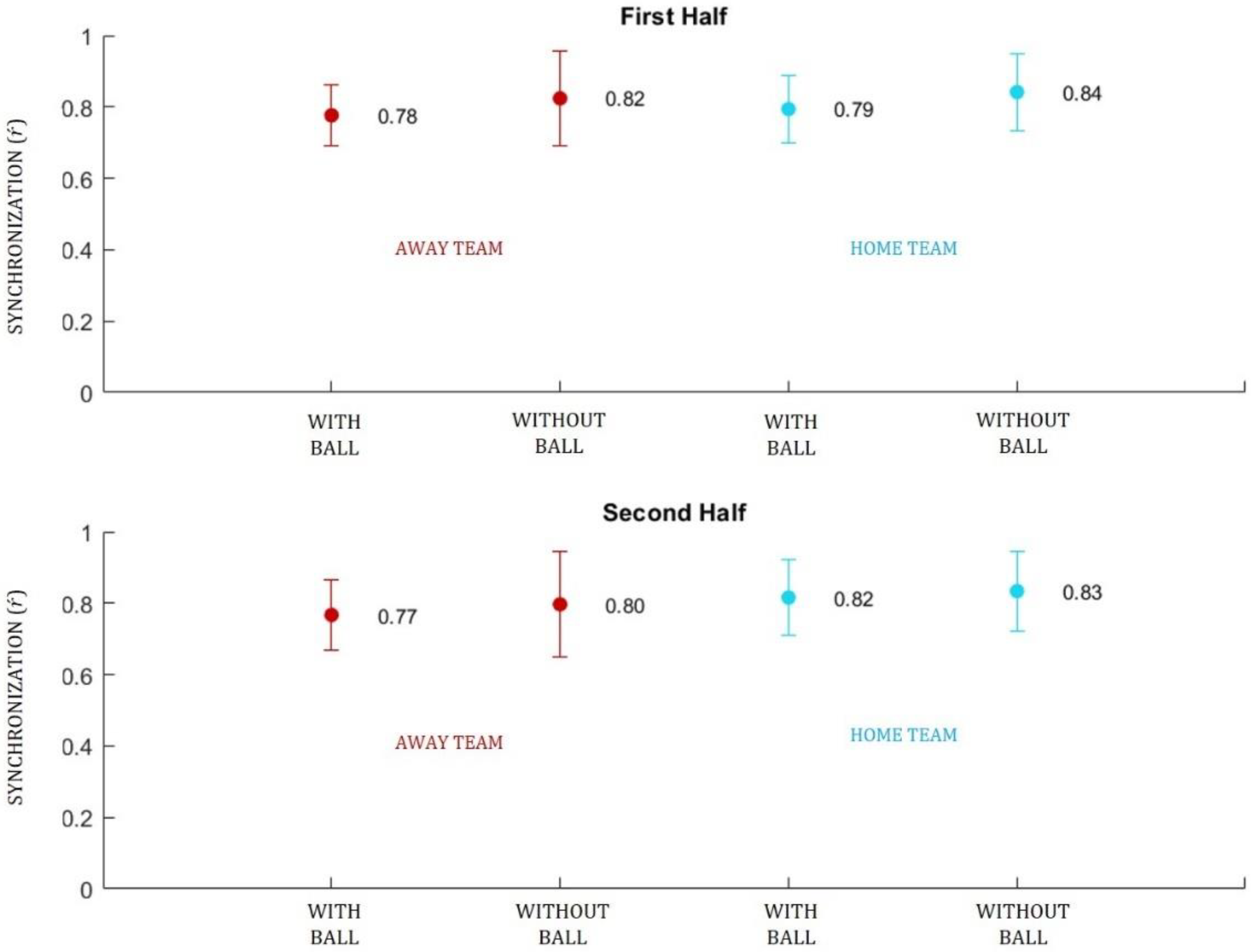
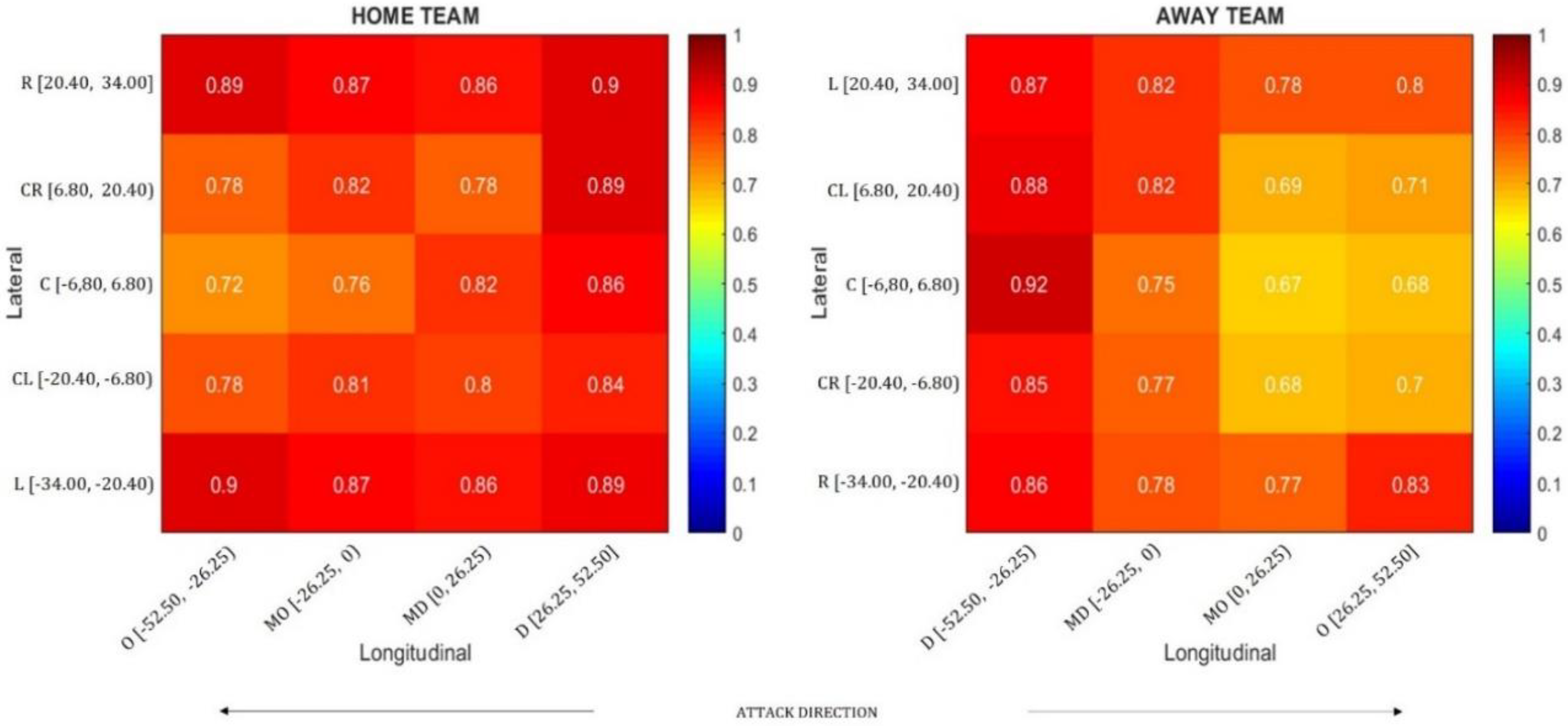
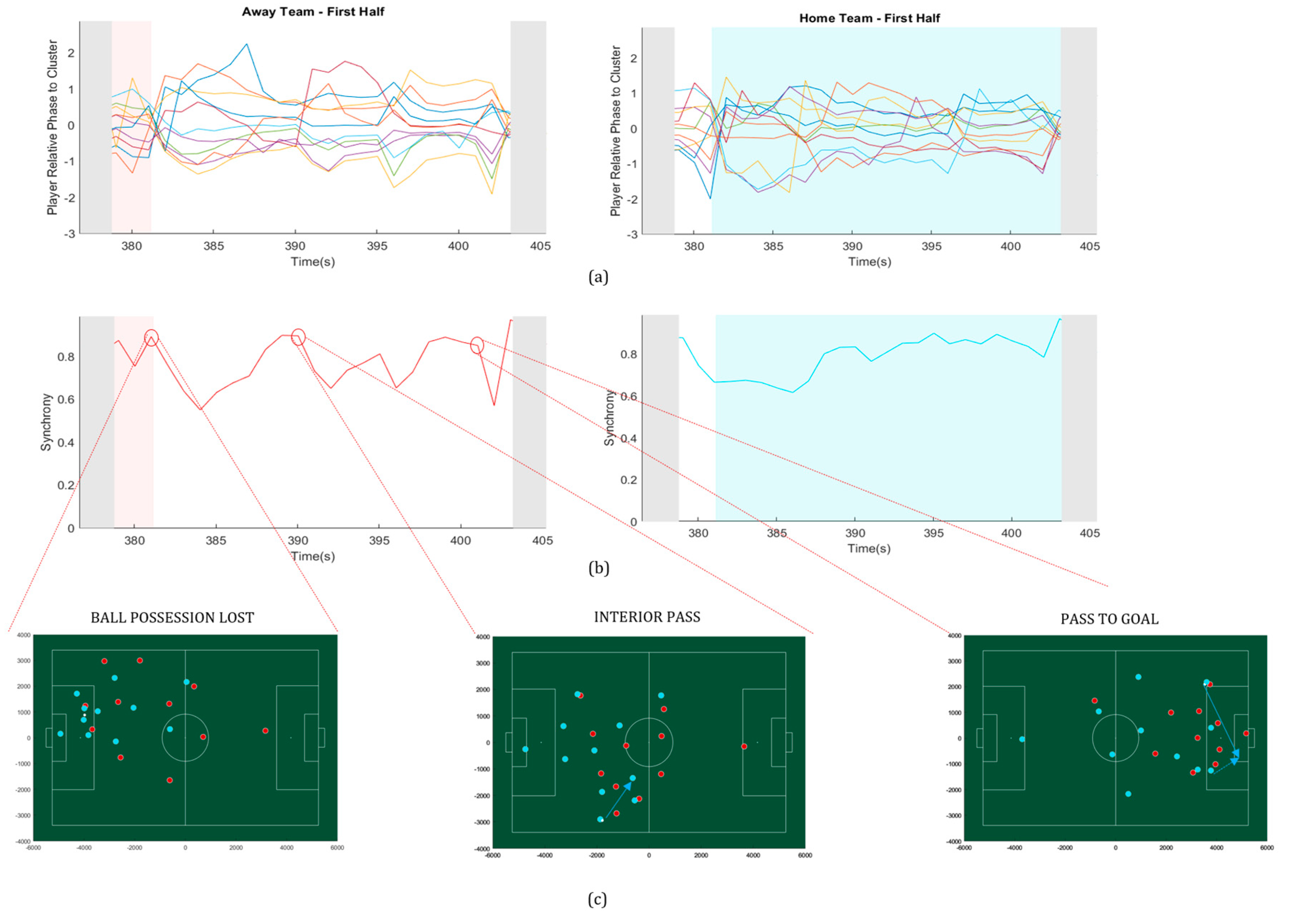
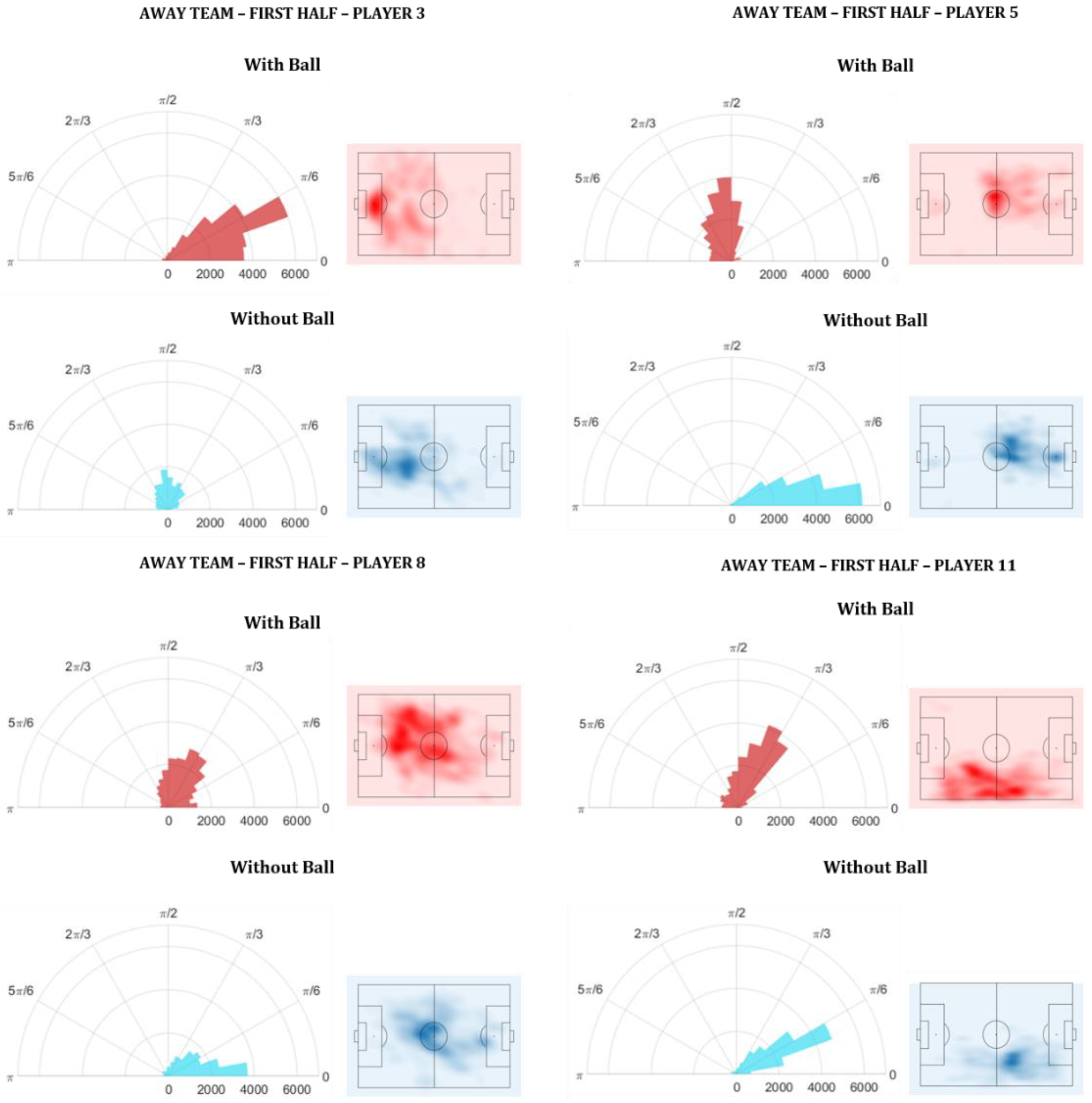
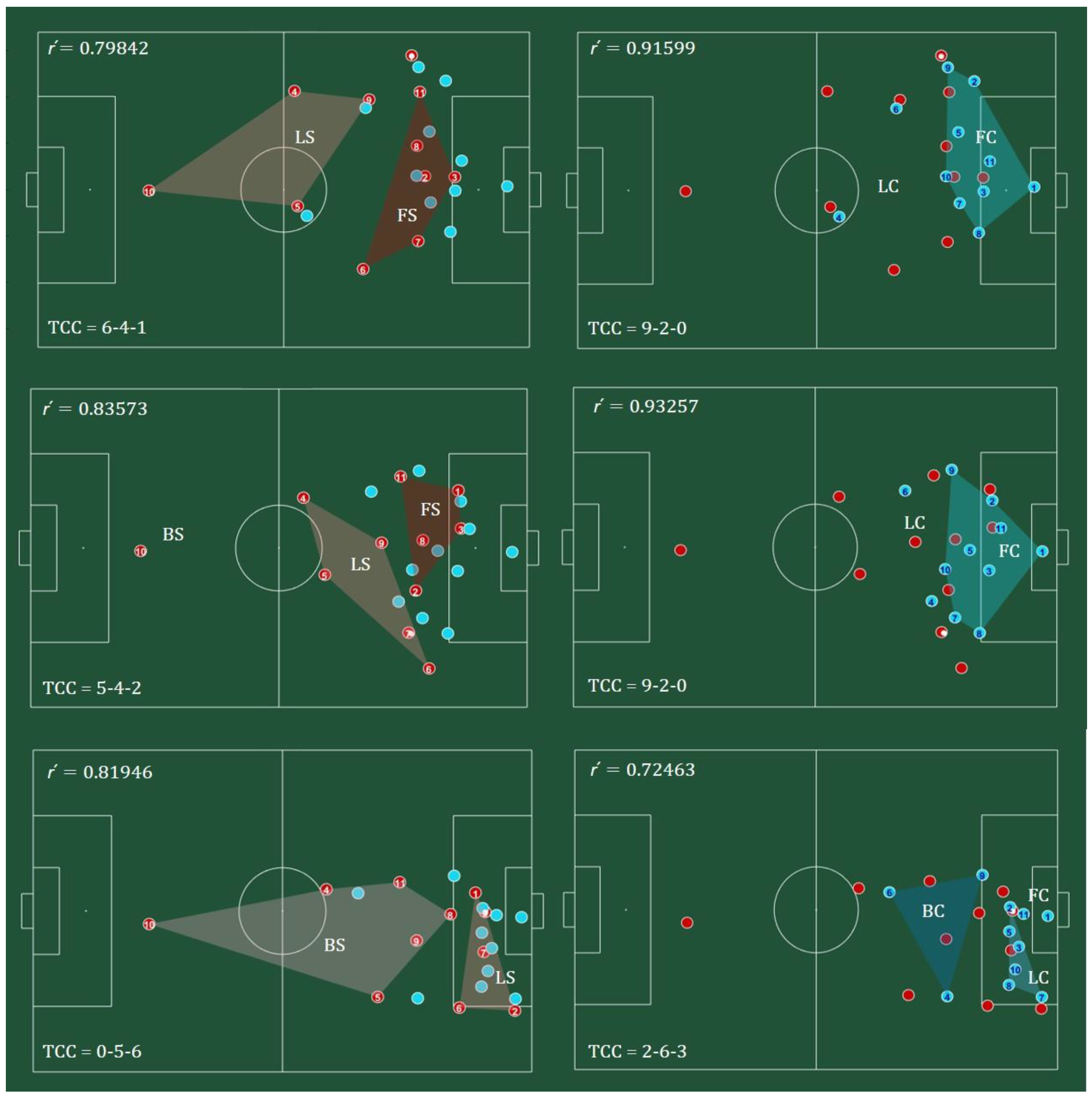
| Interaction | Statistical Significance |
|---|---|
| team x role | |
| lateral zone x longitudinal zone | |
| role x longitudinal zone | |
| role x lateral zone | |
| team x longitudinal zone | |
| team x lateral zone |
© 2020 by the authors. Licensee MDPI, Basel, Switzerland. This article is an open access article distributed under the terms and conditions of the Creative Commons Attribution (CC BY) license (http://creativecommons.org/licenses/by/4.0/).
Share and Cite
Carrilho, D.; Santos Couceiro, M.; Brito, J.; Figueiredo, P.; Lopes, R.J.; Araújo, D. Using Optical Tracking System Data to Measure Team Synergic Behavior: Synchronization of Player-Ball-Goal Angles in a Football Match. Sensors 2020, 20, 4990. https://doi.org/10.3390/s20174990
Carrilho D, Santos Couceiro M, Brito J, Figueiredo P, Lopes RJ, Araújo D. Using Optical Tracking System Data to Measure Team Synergic Behavior: Synchronization of Player-Ball-Goal Angles in a Football Match. Sensors. 2020; 20(17):4990. https://doi.org/10.3390/s20174990
Chicago/Turabian StyleCarrilho, Daniel, Micael Santos Couceiro, João Brito, Pedro Figueiredo, Rui J. Lopes, and Duarte Araújo. 2020. "Using Optical Tracking System Data to Measure Team Synergic Behavior: Synchronization of Player-Ball-Goal Angles in a Football Match" Sensors 20, no. 17: 4990. https://doi.org/10.3390/s20174990
APA StyleCarrilho, D., Santos Couceiro, M., Brito, J., Figueiredo, P., Lopes, R. J., & Araújo, D. (2020). Using Optical Tracking System Data to Measure Team Synergic Behavior: Synchronization of Player-Ball-Goal Angles in a Football Match. Sensors, 20(17), 4990. https://doi.org/10.3390/s20174990








